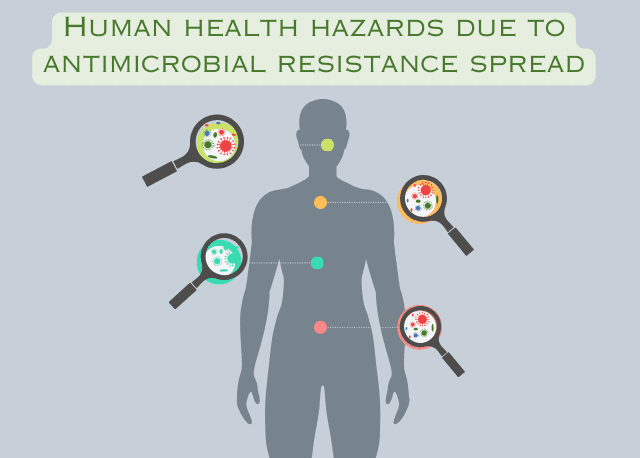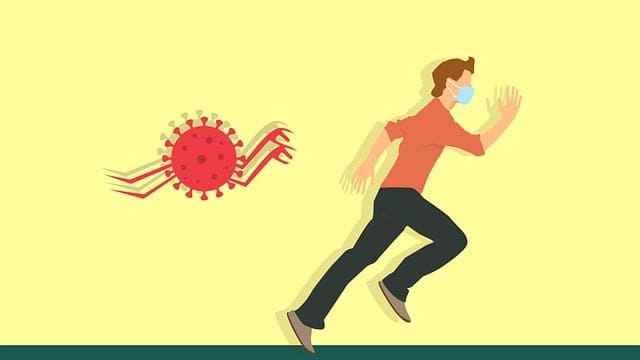Uncover health risks from antimicrobial resistance. Learn about the dangers of its spread.
Embark on a journey to explore the growing threat of antimicrobial resistance, where we examine a pressing challenge facing global public health. Discover how this trend not only threatens human health but also undermines the effectiveness of critical medicines, increasing the risk of incurable infectious diseases.
Antimicrobials prevent millions of deaths each year. Inappropriate prescribing and antimicrobial overdosing have increased resistance as a global health emergency and result in 700,000 deaths annually. The World Health Organization considers antimicrobial resistance as a global threat to human health. New resistance mechanisms are evolving and spreading globally, threatening our ability to treat infectious diseases. A growing list of infections is becoming increasingly difficult and sometimes impossible to treat. A quarter of infections after chemotherapy are caused by antibiotic-resistant organisms. The overall hospital mortality rate among patients with resistant isolates of Pseudomonas aeruginosa has been reported to be 7.6%. About 214,000 infants die a year as a result of sepsis caused by resistant bacteria, one-third of all neonatal sepsis deaths. The Centers for Disease Control and Prevention has sounded the alarm about the immediate dangers of carbapenem-resistant Acinetobacter and drug-resistant Neisseria gonorrhoeae. Serious threats to vancomycin-resistant Enterococci and drug-resistant Salmonella serotype Typhi have been described, along with concerns for Erythromycin-resistant Group A Streptococcus and Clindamycin-resistant Group B Streptococcus. Drug-resistant Mycoplasma genitalium and Bordetella pertussis are on the watch list. Antimicrobial resistance tips toward longer hospitalizations perpetuate higher medical costs and increased mortality. The risk of antimicrobial resistance is increasing at an alarming rate, especially in developing countries as a result of inappropriate use of antimicrobials. In order to reduce antimicrobial resistance and improve patient quality of life, it is important to know the mechanism of resistance to reduce the rate of resistance and patient hospitalization. Outbreaks of multidrug-resistant infections in hospital settings or elsewhere highlight the need and importance of improved antimicrobial prescribing.
Human health hazards due to antimicrobial resistance spread:
The rise of antimicrobial resistance poses a significant threat to global public health, challenging the effectiveness of antibiotics and other antimicrobial drugs that have long been crucial in treating infectious diseases. Despite the life-saving benefits of antimicrobials, the misuse and overuse of these drugs have led to the emergence of resistant strains of bacteria and other pathogens, creating a pressing and complex health hazard.
Inappropriate prescribing and overdosing of antimicrobials contribute to the escalation of resistance, resulting in approximately 700,000 deaths annually worldwide. The World Health Organization recognizes antimicrobial resistance as a critical global health emergency, emphasizing its potential to undermine the cornerstone of modern medicine – the ability to effectively combat infectious diseases.
The evolution and global spread of new resistance mechanisms further exacerbate the situation, jeopardizing our capacity to treat a growing list of infections. Some diseases have become increasingly challenging, and in some cases, impossible to treat, as demonstrated by a quarter of infections occurring after chemotherapy being caused by antibiotic-resistant organisms.
The consequences of antimicrobial resistance are starkly evident in healthcare settings, with the overall hospital mortality rate among patients with resistant isolates of Pseudomonas aeruginosa reported at 7.6%. Disturbingly, about 214,000 infants succumb to sepsis each year due to infections caused by resistant bacteria, comprising one-third of all neonatal sepsis deaths.
Specific pathogens have been singled out as serious threats, such as carbapenem-resistant Acinetobacter and drug-resistant Neisseria gonorrhoeae, prompting urgent warnings from health authorities like the Centers for Disease Control and Prevention. Additionally, concerns are raised regarding vancomycin-resistant Enterococci, drug-resistant Salmonella serotype Typhi, Erythromycin-resistant Group A Streptococcus, Clindamycin-resistant Group B Streptococcus, drug-resistant Mycoplasma genitalium, and Bordetella pertussis.
Beyond the immediate health risks, antimicrobial resistance contributes to longer hospitalizations, escalating medical costs, and increased mortality rates. Developing countries, in particular, face a growing risk due to the inappropriate use of antimicrobials, further amplifying the urgency of addressing this issue on a global scale.
To combat antimicrobial resistance and enhance patient quality of life, it is imperative to understand the mechanisms of resistance and implement measures to reduce its occurrence. Improved antimicrobial prescribing practices, coupled with global efforts to raise awareness and regulate the use of these drugs, are essential to mitigate the risks associated with the rapid and alarming increase in antimicrobial resistance. The outbreaks of multidrug-resistant infections in various settings underscore the immediate need for enhanced antimicrobial stewardship and a collective commitment to preserving the effectiveness of these life-saving medications.
Conclusion:
Finally, the increasing prevalence of antimicrobial resistance emerges as a serious threat to human health globally. The multifaceted implications of this trend, marked by inappropriate prescribing, overuse, and the evolution of new resistance mechanisms, paint a bleak picture for the future of infectious disease management. The grim reality of 700,000 annual deaths underscores the urgency of addressing antimicrobial resistance as a major global health emergency recognized by the World Health Organization.
The impact of resistance is evident in healthcare settings, with higher mortality rates in patients fighting infections caused by resistant strains. Alarming statistics, such as a quarter of post-chemotherapy infections being antibiotic resistant, and the tragic number of neonatal sepsis deaths attributable to resistant bacteria, demand urgent attention.
Specific threats posed by pathogens such as carbapenem-resistant Acinetobacter, drug-resistant Neisseria gonorrhoeae, vancomycin-resistant Enterococci, and others add to the complexity of the problem. Urgent warnings from health authorities about these threats underscore the need for a coordinated global response.
Antimicrobial resistance not only leads to longer hospitalizations and increased medical costs, but also contributes to eroding our ability to effectively fight infectious diseases. The disproportionate impact on developing countries due to inappropriate antimicrobial use adds another layer of urgency to the crisis.
To mitigate these risks, a holistic approach is necessary. Improved antimicrobial prescribing practices, along with global awareness campaigns and regulatory initiatives, are critical in preventing the rapid rise of resistance. The outbreak of multidrug-resistant infections is a stark reminder of the urgent need for antimicrobial stewardship and the united commitment to preserve the efficacy of these life-saving drugs.
In summary, combating antimicrobial resistance requires a collective effort from health care professionals, policy makers, and the general public. This requires responsible antimicrobial use, ongoing research to understand resistance mechanisms, and a commitment to developing innovative solutions to ensure the sustainability of our ability to treat infectious diseases. Only through a coordinated global effort can we hope to reduce the risks to human health posed by the continued spread of antimicrobial resistance.
Remember, AMR is a complex and urgent issue, but by understanding its dangers and taking individual and collective action, we can slow its spread and protect the health of ourselves and future generations.
FAQs about Human Health Hazards due to Antimicrobial Resistance (AMR):
Q: What is antimicrobial resistance?
A: AMR occurs when microbes (bacteria, viruses, fungi, parasites) develop resistance to the drugs designed to kill them. This makes infections harder to treat, increasing the risk of serious complications and death.
Q: How does AMR spread?
A: Overuse and misuse of antimicrobials like antibiotics in humans and animals, poor sanitation, and lack of hygiene contribute to the spread of resistant microbes. They can be transmitted through direct contact, contaminated food and water, and even the environment.
Q: How dangerous is AMR?
A: AMR is a major global threat, estimated to cause 1.27 million deaths and contribute to 4.95 million deaths in 2019. Resistant infections lead to longer hospital stays, higher healthcare costs, and increased risks of mortality and disability.
Q: Which infections are most affected by AMR?
A: Common infections like pneumonia, urinary tract infections, and bloodstream infections can become severe and difficult to treat due to AMR. This affects surgeries, cancer treatments, and other procedures that rely on effective antibiotics.
Q: Is there anything we can do to stop AMR?
A: Yes! Reducing unnecessary antibiotic use in humans and animals, developing new antibiotics and alternative therapies, promoting good hygiene, and improving sanitation are crucial steps in tackling AMR.
Q: What can I do personally to prevent AMR?
A: Only use antibiotics prescribed by a doctor and complete the entire course. Practice good hygiene like handwashing, avoid sharing medications, and encourage responsible antibiotic use in your community.
Q: Are there any resources where I can learn more about AMR?
A: The World Health Organization (WHO), the Centers for Disease Control and Prevention (CDC), and the Alliance to Stop Antibiotics Abuse (ASA) all offer comprehensive information on AMR.
Q: What is the future of medicine with AMR on the rise?
A: AMR creates a worrying scenario where common infections become potentially life-threatening. Investing in research, promoting responsible antibiotic use, and adopting alternative strategies are critical to ensure the effectiveness of antibiotics and protect future generations.






